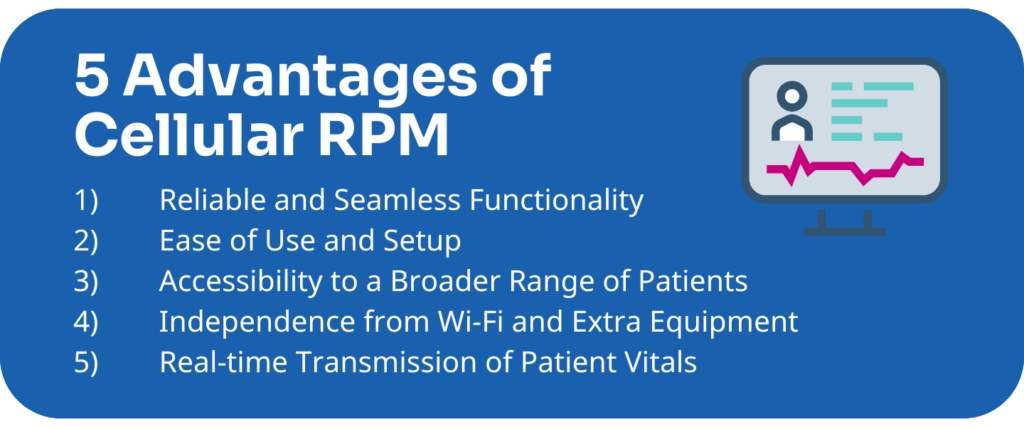When it comes to healthcare technology, the choice between Bluetooth versus cellular remote patient monitoring (RPM) devices can spark a passionate debate. Health systems seek innovative solutions to enhance patient care, prioritizing user-friendly design and comprehensive services, all while aiming to control costs and ensure the timely transmission of critical patient data. So the question remains, which is the best option?
The Cellular RPM Advantage
When it comes to the availability of RPM devices – like those designed to monitor blood pressure, glucose, and weight – there is no shortage of options. However, amid this abundance, one connectivity solution stands out for its clear simplicity and efficiency: cellular technology. Cellular RPM devices excel in providing predictable, seamless functionality, standing out not just as a choice but as a strategic ally in delivering the ideal healthcare experience.
How Does a Cellular RPM Medical Device Work?
With recent studies revealing that 70% of Bluetooth RPM users experience issues when sending readings, it’s evident that the primary advantage of cellular RPM lies in its method of transmission. Cellular RPM devices operate independently of Wi-Fi and don’t require a tablet for connectivity, unlike Bluetooth devices. This key distinction can significantly reduce the burden on both patients and providers, eliminating the need for expensive wireless internet access and technical support.
With cellular RPM devices, connectivity relies on cellular networks, just like how a mobile phone operates. This means that patients don’t need a Wi-Fi connection or additional equipment to use the device. Cellular technology allows for a more straightforward setup, making it accessible to a broader range of patients, including those who may face challenges with internet connectivity or lack the necessary technical expertise to troubleshoot issues on their own.
The increased reliability of cellular technology also allows patient vitals to be transmitted to providers in real-time. With automatic data collection, care teams can make more informed, proactive recommendations to improve the well-being of their patients. As healthcare systems and providers aim for optimal patient outcomes, the path paved by cellular RPM technology becomes increasingly appealing.
Expanding Access to Care with Cellular RPM
Closing the health equity gap has become a shared commitment within the healthcare industry. For entities such as federally qualified health centers (FQHCs), rural health centers (RHCs), and community-based healthcare providers, the advent of mobile health monitoring programs unfolds as a transformative force, extending a lifeline to those often underserved.
In rural landscapes and among communities with limited tech literacy, cellular RPM devices serve as profound catalysts of change. Beyond simply augmenting healthcare accessibility, these devices redefine the quality of care in remote areas. By bridging the geographical gap between patients and healthcare providers, cellular RPM programs actively involve patients in effective disease management, and instill a sense of empowerment, enabling individuals to make better informed decisions about their health.
The marriage of virtual, cellular, and user-friendly RPM devices is a beacon of hope, illuminating a path towards comprehensive healthcare equity for individuals navigating the complexities of chronic illnesses.

TimeDoc Health and Cellular-Connected Remote Monitoring
The cellular RPM advantage is increasingly clear. Cellular RPM is not merely a technological choice; it’s a strategic decision to revolutionize patient care.
With TimeDoc Health Remote Patient Monitoring, cellular RPM devices can be delivered directly to the patient’s home and include minimal setup guided by a dedicated Care Coordinator. TimeDoc Health combines remote care services with popular types of FDA-registered mobile health devices, including blood pressure monitors, glucose monitors, pulse oximeters, and smart scales. Providers can rest assured that critical readings are consistently delivered, enabling them to more effectively care for their patients.
In a world where every connection matters, cellular RPM serves as a bridge between healthcare providers and those they serve, promising a future where healthcare is not only accessible but tailored to meet the unique needs of every individual.
Request a demo to learn more about how TimeDoc Health delivers real-time insights for better care.

